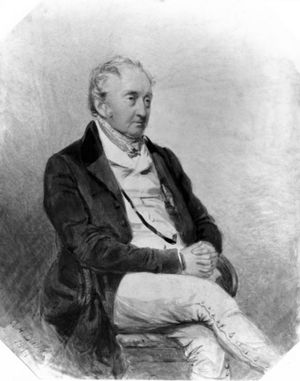John Kennedy (manufacturer) facts for kids
Quick facts for kids
John Kennedy
|
|
|---|---|

by Charles Allen Duval, 1844
|
|
| Born | 4 July 1769 Knocknalling, Kirkcudbrightshire
|
| Died | October 30, 1855 (aged 86) Ardwick Hall, Manchester
|
| Nationality | British |
| Occupation | Engineer Textile machine maker Cotton spinner Textile industrialist |
| Known for | The Jack Frame Double Speed spinning machinery Sedgewick Mill Rainhill locomotive trials |
John Kennedy (born July 4, 1769 – died October 30, 1855) was an important Scottish businessman. He was known for his work in the textile industry in Manchester, England. He helped create new machines and build large factories for making cotton.
Contents
Early Life and Training
John Kennedy was born in 1769 in Knocknalling, a place in Kirkcudbrightshire, Scotland. When he was 15, in 1784, he moved to Chowbent in Lancashire. There, he started an apprenticeship with William Cannan. An apprenticeship is like a training program where you learn a skill or trade from an expert.
During his training, John learned how to make machines for the textile industry. This included machines like carding engines, jennies, and water frames. These machines were very important for turning raw cotton into thread.
After finishing his training in 1791, John moved to Manchester. He teamed up with James McConnel, who was also a former apprentice. They started a business together. They made textile machines and also spun cotton themselves. John was a very clever engineer. He invented a key improvement for spinning machines called "double speed." This invention made it possible to create much finer and better quality thread.
Building a Business
In 1795, John Kennedy and James McConnel became financially independent. They moved their business to a new factory on Canal Street in Manchester. For the first few years, they mainly built cotton-spinning machines to sell to other businesses.
Around 1800, they decided to focus only on spinning cotton yarn. They built their first large spinning mill in Ancoats, Manchester. This mill was called the Sedgewick Mill. It was eight stories tall and was the largest building in the world at the time to use a cast iron frame. Their company became the biggest cotton spinning business in Manchester. They were known for making the highest quality yarn.
Later Interests and Legacy
As he got older, John Kennedy spent more time on his interests in technology and machines. He was asked for his advice about the Liverpool and Manchester Railway, which was a very important new train line. He strongly supported its creation.
In 1829, John was chosen to be a judge at the famous Rainhill locomotive trials. This was a competition to find the best steam locomotive for the new railway. He worked alongside other famous engineers like John Urpeth Rastrick and Nicholas Wood.
John was also an active member of the Manchester Literary and Philosophical Society. He wrote four important papers for the society. These papers discussed different industrial and social topics of his time.
Death
John Kennedy passed away in 1855 at Ardwick Hall in Manchester. He was buried in the nearby Rusholme Road cemetery. He had several children, including his son John L. Kennedy, who became a lawyer.
Images for kids
-
Hall i' th' Wood near Bolton; where Mr. Crompton constructed the first spinning mule. To John Kennedy, Esq. and the Cotton-Spinners of Lancashire, this plate is respectfully dedicated, by the publishers. Fisher, Son and Co. London 1829. Engraving by Thomas Dixon after a drawing by John Harwood. Originally published in William Henry Pyne's partwork Lancashire Illustrated, from Original Drawings (1828-1831).
See also


